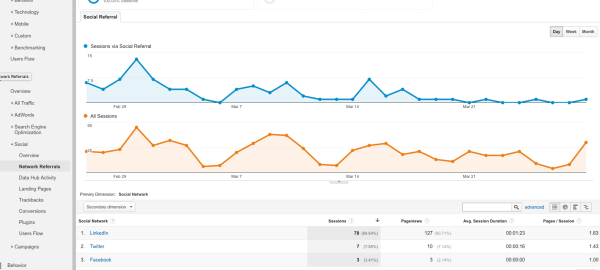 There are a lot of ways to measure success. According to a recent survey, the way that most small and medium sized businesses measure the success of their social marketing efforts is through views. In fact, 51% of these businesses measure success by the number of views. This is followed by the number of posts, and then by interactions with each of these activities getting 34%.
There are a lot of ways to measure success. According to a recent survey, the way that most small and medium sized businesses measure the success of their social marketing efforts is through views. In fact, 51% of these businesses measure success by the number of views. This is followed by the number of posts, and then by interactions with each of these activities getting 34%.
Need For ROI Increases With Effort
Measuring the ROI of social media has been one of the hardest equations marketers have had to try to figure out since real marketing metrics became available. Just like a lot of SMB’s, you probably started your social marketing efforts by having someone write some posts, either on a blog or on a social platform like Facebook, Twitter, or LinkedIn. You started to see some activity so you dedicated more effort to it. Then you started to read a lot of articles about the value of social marketing and maybe even heard some people in your industry talk about the importance of social marketing.
So, you decided to get real serious about marketing in the social channel and now you’ve either hired an agency or you’ve brought on someone as your in-house person that is going to focus just on your social marketing effort. You’ve probably been at this for a little while and now you’re trying to figure out exactly what your return on this effort really is.
So, How Do You Measure
Knowing what to measure is the first step in trying to figure out what you’re getting for the money that you are now spending and based on this chart, above by Clutch, it looks like most SMB’s are still struggling with what to measure. In fact, the measurement that most are looking at is, views. It’s good that businesses are looking at it, but it may not be the best thing to measure.
Measuring views on social marketing channels is like measuring traffic for your website. Without having traffic, your website has no value. You need traffic for people to learn about you, but not all of the traffic is quality traffic. Views are the same thing. You need them to get your message out there, but just because someone views your posts doesn’t mean that you’re going to get more business from it. In fact, the likelihood that someone would view your post and take immediate action to become a customer is highly unlikely.
The tough part about measuring social is that it is a more passive marketing channel. That means that you’re typically building relationships, or increasing the visibility of your brand, on the social platforms. So, generally speaking, you’re not going to have someone go from your latest LinkedIn post to your contact us form. But, you could have them go from that latest post to your product page to learn more about what you wrote about in your post.
Measure Social On Your Website
 You can, however, measure the impact that your social posts are having, by looking at the traffic that your posts are sending to your website. Having your social posts direct people to your website has multiple benefits.
You can, however, measure the impact that your social posts are having, by looking at the traffic that your posts are sending to your website. Having your social posts direct people to your website has multiple benefits.
First, this is where you want them to go, to begin with. Your website is where you can start to educate a potential customer on the products and services that you provide. Your website is where you can start building on your business relationship with this potential new customer.
Secondly, by driving these people to your website you can start to track what they are interested in. You can see in your analytics reports what pages they are visiting, what products they are looking for and how well they are engaging with your website.
This means that you have to measure the impact of your social posts on your website traffic and once they get to your website, then you can measure what they do from there. To see this metric, login to your Google Analytics account and navigate to Acquisition > Social > Network Referrals Here you’ll see the traffic coming to your site from the different social platforms.
Digital & Social Articles on Business 2 Community(32)
Report Post





